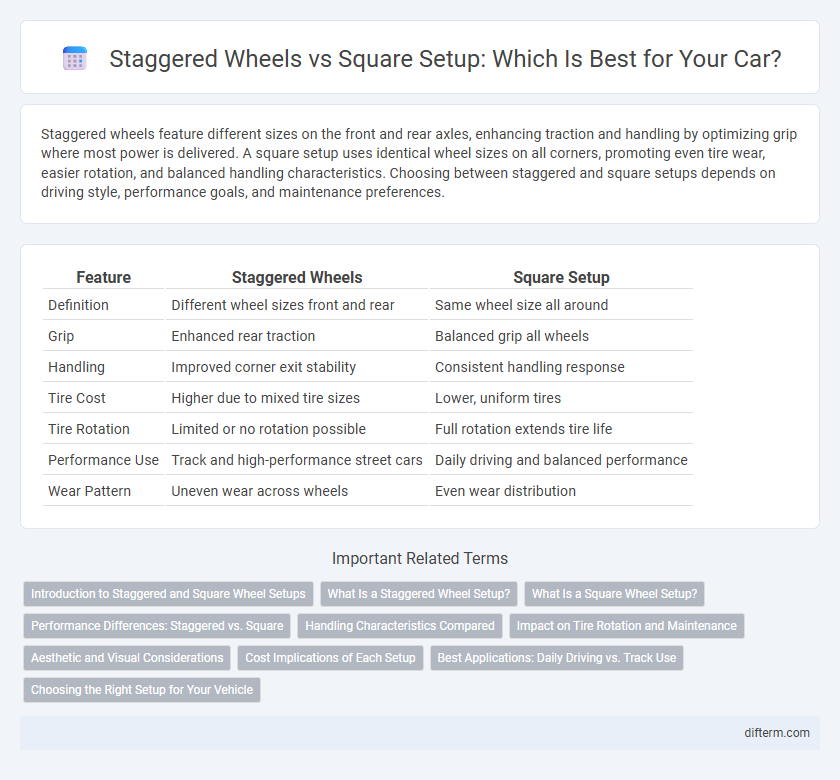Staggered wheels feature different sizes on the front and rear axles, enhancing traction and handling by optimizing grip where most power is delivered. A square setup uses identical wheel sizes on all corners, promoting even tire wear, easier rotation, and balanced handling characteristics. Choosing between staggered and square setups depends on driving style, performance goals, and maintenance preferences.
Table of Comparison
| Feature | Staggered Wheels | Square Setup |
|---|---|---|
| Definition | Different wheel sizes front and rear | Same wheel size all around |
| Grip | Enhanced rear traction | Balanced grip all wheels |
| Handling | Improved corner exit stability | Consistent handling response |
| Tire Cost | Higher due to mixed tire sizes | Lower, uniform tires |
| Tire Rotation | Limited or no rotation possible | Full rotation extends tire life |
| Performance Use | Track and high-performance street cars | Daily driving and balanced performance |
| Wear Pattern | Uneven wear across wheels | Even wear distribution |
Introduction to Staggered and Square Wheel Setups
Staggered wheel setups feature wider rear wheels for enhanced traction and aggressive styling, commonly used in performance and rear-wheel-drive vehicles. Square setups use identical wheel and tire sizes on all four corners, promoting balanced handling and simplified rotation patterns ideal for daily driving and motorsports. Choosing between staggered and square setups depends on the vehicle's drivetrain, performance goals, and aesthetics.
What Is a Staggered Wheel Setup?
A staggered wheel setup features different sized wheels and tires on the front and rear axles, typically wider at the rear for enhanced traction and performance. This configuration improves handling balance, especially in rear-wheel-drive vehicles, by optimizing grip during acceleration and cornering. In contrast to a square setup where all wheels are the same size, staggered setups often contribute to a more aggressive stance and improved stability at high speeds.
What Is a Square Wheel Setup?
A square wheel setup features identical tire sizes on both the front and rear axles, providing uniform traction and handling characteristics. This configuration enhances tire rotation options, leading to more even tire wear and extended lifespan. Commonly used in performance vehicles, square setups balance grip and stability for improved all-around driving dynamics.
Performance Differences: Staggered vs. Square
Staggered wheels feature wider rear tires compared to the front, enhancing traction and cornering stability in rear-wheel-drive sports cars, while square setups use equal tire sizes on all wheels, promoting even tire wear and easier rotation. Performance differences reveal that staggered setups excel in straight-line acceleration and high-speed grip but may induce understeer during aggressive cornering. Square setups offer balanced handling characteristics with more predictable feedback and improved tire longevity, making them preferred for all-wheel-drive vehicles and balanced track performance.
Handling Characteristics Compared
Staggered wheels, featuring wider rear tires, enhance traction and cornering stability by improving rear grip and reducing oversteer tendencies in high-performance vehicles. In contrast, a square setup with equal-sized tires promotes balanced handling, more predictable steering response, and even tire wear, benefiting all-wheel-drive systems and daily driving scenarios. Choosing between staggered and square setups depends on driving style and vehicle dynamics, with staggered ideal for aggressive rear traction and square preferred for consistent handling balance.
Impact on Tire Rotation and Maintenance
Staggered wheels, with differing sizes on the front and rear, complicate tire rotation since tires cannot be swapped between axles, leading to uneven wear and increased maintenance costs. A square setup, featuring identical tire sizes on all wheels, simplifies tire rotation by allowing all four tires to be moved interchangeably, promoting even tread wear and extending tire lifespan. Choosing a square setup enhances maintenance efficiency and reduces the frequency and cost associated with tire replacements.
Aesthetic and Visual Considerations
Staggered wheels, featuring wider rear tires and narrower front tires, create a more aggressive and sporty stance, enhancing the vehicle's visual appeal through a dynamic, forward-leaning appearance. In contrast, a square setup with equal tire sizes on all corners promotes a balanced and symmetrical look, often preferred for a clean, uniform aesthetic. The choice between staggered and square setups significantly impacts the car's profile, influencing perceptions of performance and style within automotive design.
Cost Implications of Each Setup
Staggered wheel setups, featuring wider rear tires than front, typically incur higher costs due to the need for specialized tires and potential limitations in tire rotation, leading to more frequent replacements. Square setups use identical-sized tires on all four corners, allowing for cost savings through uniform tire inventory and easier rotation, which enhances tire longevity and reduces overall maintenance expenses. Choosing between staggered and square setups directly impacts tire replacement frequency, inventory management, and long-term cost efficiency in automotive maintenance.
Best Applications: Daily Driving vs. Track Use
Staggered wheels, featuring wider rear tires, provide enhanced traction and stability ideal for high-performance track use, improving cornering grip and acceleration. A square setup, with equal tire sizes on all corners, offers balanced handling and easier tire rotation, making it more practical for daily driving and consistent wear. Choice between setups depends on priorities: staggered wheels suit aggressive driving and track conditions, while square setups optimize longevity and cost-efficiency for everyday commuting.
Choosing the Right Setup for Your Vehicle
Choosing the right wheel setup depends on your vehicle's performance goals and handling characteristics, where staggered wheels, with wider rear tires, enhance traction and stability during acceleration on rear-wheel-drive cars. A square setup, featuring uniform tire sizes on all four corners, improves predictable handling, easier rotation, and balanced grip, especially in all-wheel-drive vehicles. Prioritize factors like tire wear, driving conditions, and alignment ease to maximize performance and maintain optimal tire longevity.
staggered wheels vs square setup Infographic

 difterm.com
difterm.com